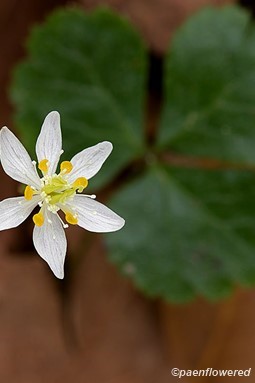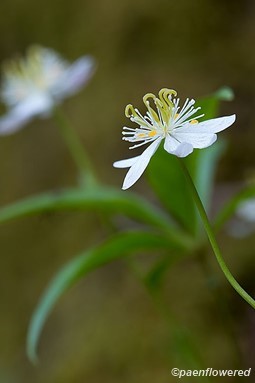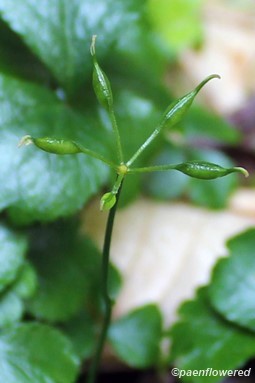Coptis trifolia
A dainty moss-loving wildflower of moist hemlock woods
Coptis trifolia threeleaf goldthread
This member of the buttercup family is a small woodland plant. It has flowers with five to seven showy sepals and small club-like petals. The sepals are white on the front but are often shaded with brown or gray on the back. These sepals tend to fall off early in the blooming period. There is one flower per plant borne on a leafless stalk. Each blossom is about 0.5 to 0.75 inches in diameter. The stamens are numerous and there are several pistils.
The fruit is a pod with several sides that opens along one side to release several seeds. The underground rhizomes are bright yellow and shiny. These have been used as a source of dyes. The leaves are dark and evergreen and 1 to 2 inches long. They are divided into three wedge-shaped parts and are notched. They rise on long petioles from the root.
It is a small plant that grows 3-6 inches tall in cool woods and bogs. It often grows in association with various kinds of moss. The range of this species is from Canada to northern United States and south in the mountains. It is listed as endangered in Maryland. The blooming period is May to July. Another common name for this species is canker root because Native Americans and colonists chewed the rhizome to treat mouth sores. The root has been found to contain the alkaloid berberine, which has a mild sedative action.
Habitat & Range
Common in rich, moist mossy woods, bogs, and swamps. Often grows with Tsuga canadensis.
Found in the northern part of the state and along the Allegheny front.
| EMP: | FACW |
|---|---|
| NCNE: | FACW |
Phenology
Flowers late April through mid-July.
Plant Codes
S-rank: No Rank
G-rank: G5 (Secure)






Comments
Have you spotted this plant in your area? We'd love to hear about your experience! Share your comments or questions about the plant below. Comments are moderated before posting.